I have always loved the challenge of heading out into the woods and attempting to come home with dinner. When I first started hunting as a child, one of my biggest hesitations was the fact that I didn’t know how to clean the game I was hunting.
I had seen my father and my uncle do it a few times, but I really didn’t feel comfortable doing it myself. I was always taught that we only hunt for animals that we plan to eat, so this needed to be resolved.
I took the time to ask questions and learn how to properly clean wild game. In addition to the basic process, I also learned some handy tricks to make the process easier.
Once I had cleaned a few critters, I felt much more comfortable. In this article we will take you step by step through the process of cleaning wild game so you can be more comfortable as well.
Related: The Ultimate Wild Game Meat Processing Charts for Preppers
The Basics
Understand that the process I am covering is primarily geared towards mammals. Dealing with reptiles, birds, and fish is a bit different. However, they all involve the same general steps.
With all animals you want to remove the unwanted outer layer. This is skin, scales, or feathers. You want to gut the animal removing the innards and saving the organs you want to keep. You want to inspect the animal for any signs of disease.
Finally, you want to quarter the animal for easier cooking or freezing. Whether you are working with a moose or a dove, these basics are the same.
In addition, the size of the animal does not matter as much as you would think. For this example, I am using a grey squirrel that I bagged this morning.
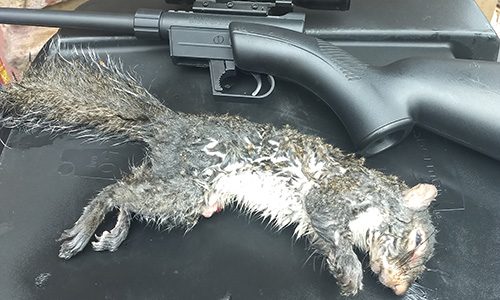
However, the process that I will cover for mammals will work for big game as well. Once you are comfortable with this process, you can apply it to any mammal. Let’s get started!
Skinning
When you are skinning a small animal like a squirrel, you can simply pull off the hide.
While this is not so easy with a deer, once you get the hide started you can pull it away from the meat much like you do with a squirrel.
The principle is the same. The mechanics are just a bit different.
Step 1 – With a sharp knife, make a small cut at the base of the tail. When you get started, it should be no wider than one inch, but you should be able to see the tail bone.
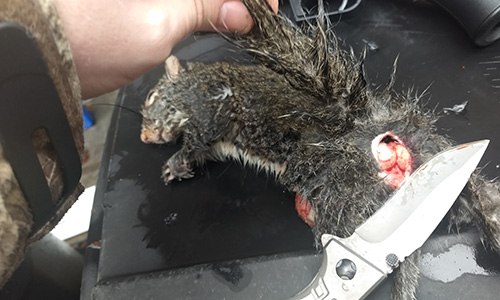 Step 2 – Break the tail bone. Usually, I can twist it to break it, or you can carefully cut through it with your knife.
Step 2 – Break the tail bone. Usually, I can twist it to break it, or you can carefully cut through it with your knife.
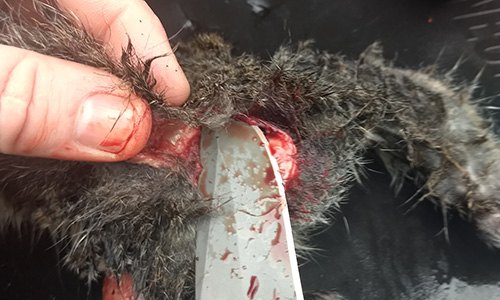 Step 3 – Extend the cut further up the back running your knife between the skin and the meat. To be clear, you are leaving the tail attached to the hide you are removing and cutting underneath.
Step 3 – Extend the cut further up the back running your knife between the skin and the meat. To be clear, you are leaving the tail attached to the hide you are removing and cutting underneath.
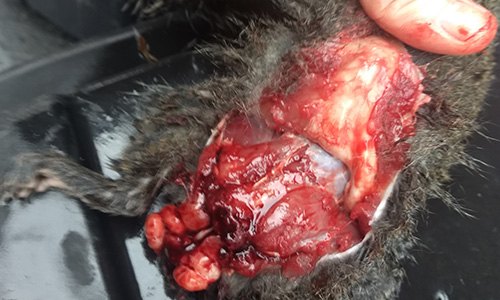
You also want to extend the cut to the sides so that you are carefully separating the skin from the leg meat. You want the flap of hide created to be a few inches wide and a few inches long so you can get your boot on the flap.
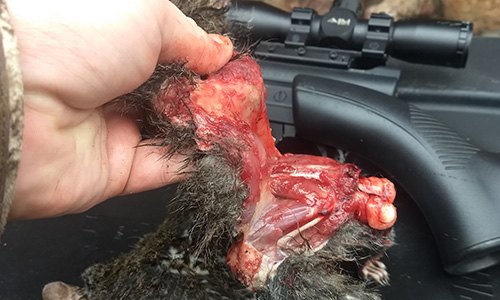 Step 4 – Lay the squirrel on its back, put your boot firmly on the skin flap, and grab the back legs with both hands. Pull straight up and the hide should come off like a sock off of a foot. Do not step only on the tail as it will pull off.
Step 4 – Lay the squirrel on its back, put your boot firmly on the skin flap, and grab the back legs with both hands. Pull straight up and the hide should come off like a sock off of a foot. Do not step only on the tail as it will pull off.
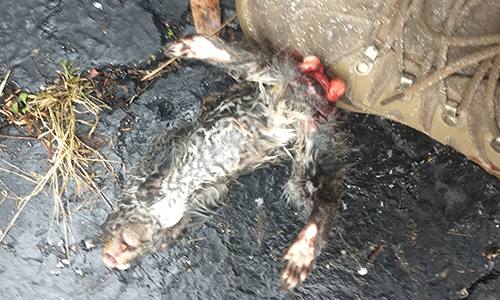 Step 5 – Find the flap of skin left on the belly running to the back legs. Grab the squirrel with one hand and the flap with the other and pull.
Step 5 – Find the flap of skin left on the belly running to the back legs. Grab the squirrel with one hand and the flap with the other and pull.
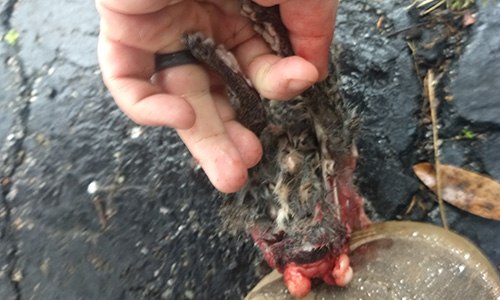 The other half of the hide should pull off the same way.
The other half of the hide should pull off the same way.
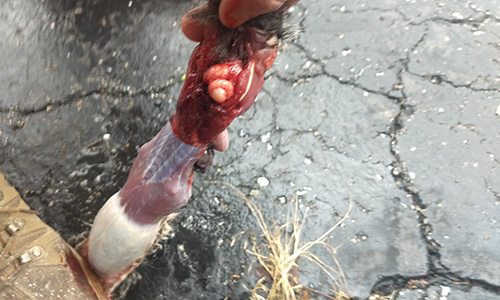 Gutting The Animal
Gutting The Animal
While gutting most animals is a similar process, there are some differences with varying animal species.
I like to keep and eat the internal organs that I can, but I must be safe as well. Some organs in different animals are not safe to eat. Be sure you know this before you start cooking.
Related: How to Keep a Slaughtered Animal From Spoiling by Eating it in the Right Order
1 – Make a cut on either side of the genitalia to remove it with the guts. Just cut along the leg meat between the legs.
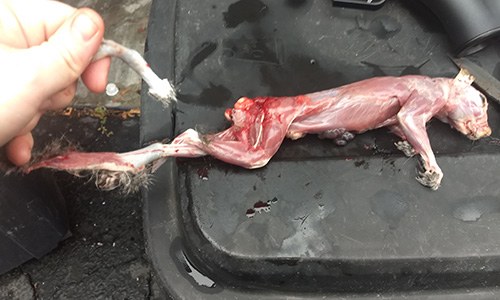 2 – Make a small incision at the base of the belly near the rear legs. Be careful to not puncture the internal organs as this would potentially taint the meat. As you cut, there should be a few layers of tissue to penetrate before you get to the internal organs.
2 – Make a small incision at the base of the belly near the rear legs. Be careful to not puncture the internal organs as this would potentially taint the meat. As you cut, there should be a few layers of tissue to penetrate before you get to the internal organs.
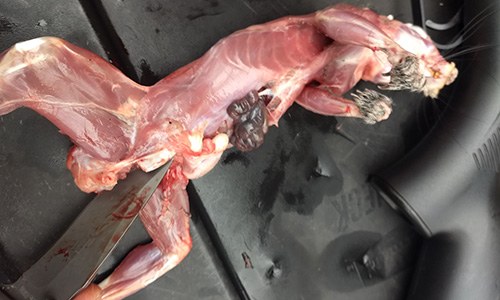 3 – Carefully open up the cavity. If you have a gut hook on your knife, insert it into the incision and cut straight up through the sternum. If you do not have a gut hook, flip over your knife so the edge of the blade faces up. Insert the point at the incision and run it up towards the sternum being careful to only cut the belly tissue and not the organs.
3 – Carefully open up the cavity. If you have a gut hook on your knife, insert it into the incision and cut straight up through the sternum. If you do not have a gut hook, flip over your knife so the edge of the blade faces up. Insert the point at the incision and run it up towards the sternum being careful to only cut the belly tissue and not the organs.
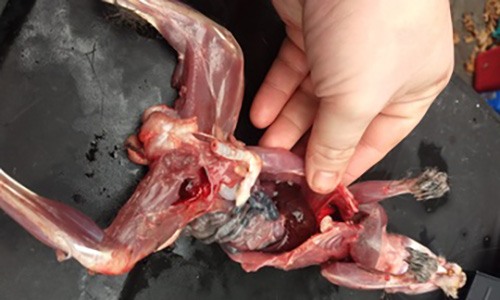 4 – Remove the organs. With small game like squirrels, you can often reach your hand in and rip everything out. If something gets stuck, you can get your blade in there and cut it loose as close to the meat as possible. This happens often with big game.
4 – Remove the organs. With small game like squirrels, you can often reach your hand in and rip everything out. If something gets stuck, you can get your blade in there and cut it loose as close to the meat as possible. This happens often with big game.
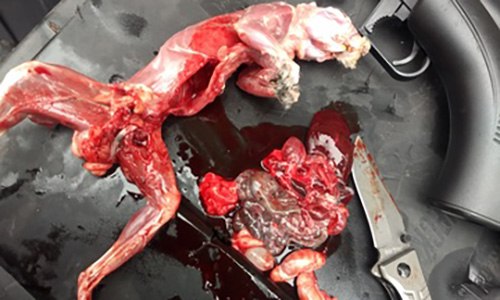 Inspecting The Animal
Inspecting The Animal
This is an often overlooked step to properly cleaning your wild game. If you want to be sure you do not get sick from the meat, take the time to check it out.
Step 1 – Rinse everything with water inside and out including the organs.
Step 2 – Check for any spots, puss, or injuries on the meat. You may need to cut and throw away portions of the meat that are not safe to eat, or you may need to discard the whole animal. If there is anything out of the ordinary, please ask an expert before consuming the meat.
Step 3 – Set out the organs and do the same inspection. Decide which organs you intend to keep and eat if any.
Related: How to Safely Store Homemade Broth for 6 Months (No Canning or Freezing Required!)
“Quartering” The Animal
This is the process of further breaking down the animal so it is easier to transport, butcher, cook, or freeze.
With big game like deer I remove the four quarters, but still remove lots of other meat from the carcass. With small game I sometimes leave them whole and sometimes make a few simple cuts so cooking is easier.
Step 1 – Remove the head and feet. You know you will not be eating these parts, so go ahead and cut these extremities off. You may need to break the bones first before you can cut through with your knife.
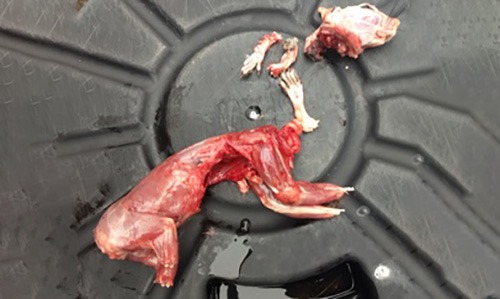 Step 2 – Remove the legs. Cut along where the legs meet the hip and shoulder joints. You should be able to easily remove these parts once you get to the joint.
Step 2 – Remove the legs. Cut along where the legs meet the hip and shoulder joints. You should be able to easily remove these parts once you get to the joint.
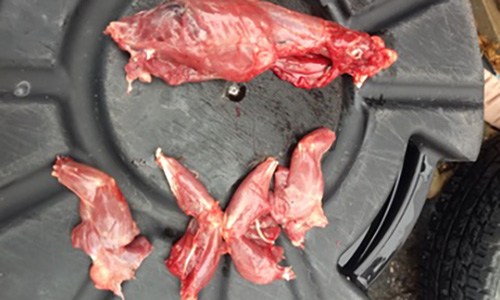 Step 3 – This is optional, but you can remove the tenderloins from the back. This muscle is one of the most tender on the animal. You can also leave it attached to the midsection and cook it that way.
Step 3 – This is optional, but you can remove the tenderloins from the back. This muscle is one of the most tender on the animal. You can also leave it attached to the midsection and cook it that way.
As you can see, it will take some practice. This is not something that will be perfect after the first try. Cleaning game is a skill just like all of our other wilderness skills. Try to practice as often as possible.
If you are hunting with other people, offer to clean their game for them to get extra practice. Go hunting or trapping more often so you have more game with which to practice.
With just a little time and effort, cleaning wild game will no longer intimidate you like it might have before.
You may also like:
The Easy and Practical DIY Snares to Catch Small Wild Game
10 Things Cowboys Carried With Them in the Wild West to Survive (Video)
The Best Way to Train Your Dog For Hunting And Security

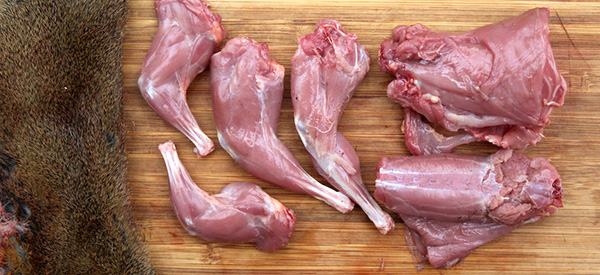
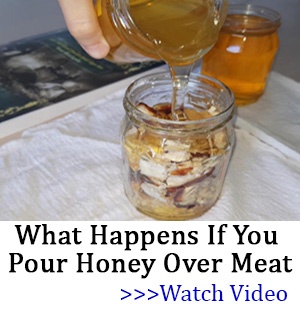













Thank you so much for sharing something without having to buy something
Thanks for sharing such information. It is very useful and informative. However, I have never hunted …
I am 64 years old and have been hunting since I was tall enough to keep the barrel out of the mud. The feeling of being in the outdoors and seeing the wonders of Mother Nature has given me memories that I cherish. If you have any friends that hunt, and you are able, please ask them to take you along once. Be warned that it may very well get you hooked which leads to heart pounding excitement, immense self satisfaction along with the same level of heartbreak. The friends you make are irreplaceable. Good luck. 🙂
Clark: I would suggest that you print this out and put it in your prepper manual. After an EOTW event, squirrel will become your all time favorite meat. You do have a prepper manual, don’t you?
You might consider using your pellet gun on little tiny squirrel-head sized targets so that you can become familiar with the distance you need to sneak up on ’em in order for you to be able to take them out with a single shot. Even .177 size pellets will do nicely on a squirrel. I don’t know how many thousands of squirrels have fallen too .177 pellets.
There is no time like the present to get started. First step is to take a hunter safety course.
Next step, if you don’t have a pellet rifle is to acquire a pellet rifle. I would suggest Pyramidair.com. Look for a pellet rifle in .22 caliber. An integrated sound suppressor is desirable and look for a muzzle velocity of 800 fps or more with normal weight .22 pellets. If it has a recommended scope with it, get it with the scope mounted and zero’d. It will save you a lot of effort. It is a little extra but worth it. Get the $20 worth of testing. That is worth it too. If there is anything loose or crooked that is the time to shake it out, when it is with folks who have a lot of experience in assessing air guns. When looking at advertised muzzle velocity, always check the lawyer language in the tiny print at the bottom of the ad. It usually refers to light weight pellets. What you want is the muzzle velocity with standard weight pellets. You can figure out what that is by looking at the advertised weight. The biggest number of pellets in .22 is the standard weight. Pellets come light weight, standard weight and heavy weight. Each has its own advantages but standard weight is the most common and the most easily found. If you stick to one weight for 99% of your shooting, you will know where that pellet is going each time you shoot. You might try other weights to see if your airgun likes light or heavy or standard weight before you load up with your selection.
No, I am not working for Pyramid as a hidden sale rep. I have dealt with them for over 20 years and have always been satisfied with their service. In addition, they have a wide selection of stock and mail out to their customers a very informative catalog about every quarter or so with lots of good information about air guns. Most of what I know about them has come from that catalog.
The next step is to acquire a hunting license and then the final step is to get out in the woods and practice on squirrels and rabbits. Rabbits are much harder than squirrels with a pellet gun but when you get the hang of it they will fall too. You don’t want to wait until your little one is crying, “Daddy, I’m hungry” to take up hunting for more than dandelion greens.
I notice from the pictures that the author doesn’t use gloves when skinning the animal. While I realize that for tens of thousands of years mankind has skinned all kinds of animals from wild to domestic without gloves, in an end of the world situation we want to do everything we can to avoid contracting infections of any kind. I would suggest using gloves when dressing game. A small nick in your skin while handling game could well lead to a life-threatening infection.
Now is the time to become accustomed to using gloves while handling game or any other animals.
For those who think they can’t skin an animal wearing gloves, I would remind them that surgeons perform extremely delicate operations such as eye surgery, brain surgery, heart surgery all the while wearing gloves. If an eye doctor can remove the cornea of the eyeball and replace it with a clear plastic lenses and stitch it into place (although with the new lenses they don’t stitch them in place any more) all the while wearing gloves, you sure as heck ought to be able to skin a squirrel with gloves on. Don’t have to worry about malpractice suits either. The squirrel isn’t in a position to complain.
The final argument in favor of gloves is that sometimes one doesn’t find out that the animal is diseased until examining the internal organs. Oops. A little late then.
Second the gloves! We buy the Nitrile non latex gloves at Costco very cheap. I have as many as I can stuffed into empty medicine bottles in my hunting pack, tackle box, all vehicle glove compartments and my tool box. There is also a box in the kitchen for cooking. I really don’t like working on the car/truck and trying to get the grease from under my nails or getting battery acid on my skin so the gloves are perfect. If I happen upon an accident and need to render aid to someone who is bleeding I have them. Wife needs you to mix the ground meat for meat loaf or meatballs…perfect. While hunting and cleaning game they also give you a better grip when skinning Elk when you get the inner layer of fat exposed. The animal to inspect the closest for me is rabbits. Any spots on the liver and throw the whole thing away. They can carry a disease that humans can contract. Great article Claude!
Awesome…if you use other than the G**gles or MS Edge..like Brave or Duck Duck Go…to search videos. You can find really good Field dressing and processing videos
Great article!! Lots of great info & tips. You made it look easy in the photos. Squirrels was always one of the most difficult things for me to field dress. Cotton tail rabbits was one of the easiest for me. Whitetail-deer was a chore but like you said the basics are the same just on a larger scale.
We always pulled the hide off of anything as soon as possible too so the carcass could cool and not spoil. If you think about it their hide is their insulation and designed to keep body heat in. So like you said in the article remove the hide as soon as possible to allow the carcass to cool.
I’ve never eaten them but my mother told me when my grandpa went squirrel hunting he always liked the brains with scrambled eggs and it was my mom’s job to cook them for him. I guess grandma couldn’t or wouldn’t fix them. Lol. Can’t say as I blame her.
Again, thanks for a great article!
Good article! Thanks for the step.by step instructions and all of the pictures.
For larger game, I’ve always:
1) Cut the neck first to drain all the blood out
2) Then carefully cut the skin from the throat of the animal down to the sex organ. Making certain you don’t cut too deep to puncture inner organs, especially the stomach.
3) Carefully remove inner organs
4) Hang the animal up by either the front or hind two legs
5) Then remove the fur. If the animal is still warm, then the fur peels off easily. If not, carefully remove with help of knife.
The main thing is that I remove the inner organs right away after bleeding out, so that you reduce the chance of puncturing them and contaminating the meat before skinning.
I have been on here for a little while and just want to thank you for these pages. I have learned many things and want to learn more. I am one step above newbie at prepping. And still need to know lots more. I was raised in a mountain town so the woods were always part of home. In the summer we would go out camping for days at a time. But in the decades that have past. many things were put far back in the mind. And reading these pages brings them up. And gives more knowledge to protect my family and myself. And I just wanted to thank you for taking the time to write these.
Nice article.
To know if an animal is not sick, it is first important to make sure that the animal makes a healthy impression while hunting.
Predators choose the weak and sick animals. for humans that is precisely not the intention, despite the fact that these animals are easier to hunt.
However, it is always difficult to know whether an animal is completely healthy.
Never use an animal for consumption if you have not seen it alive, after all you do not know how long it has been dead and what it died on.
Also leave animals that are still warm to the touch, they may appear fresh but may be full of bacteria or parasites.
I have been a taxidermist for over 10 years and I know something about it.
Greetings from the Netherlands.
Tigron
There is an interesting website entitled Wildharvesttable.com that lists the nutritional value information for wild foods, such as squirrel.
Good reference. Lots of recipes for beaver, groundhog, squirrel and rabbit. Six squirrels equals serving for eight people with 380 calories per serving. Approved by Weight Watchers. I added the last bit for a little humor I hope.
Very good advice, Tigron. Thanks for posting.
Field studies consistently show predators are adapted to catching the healthiest animals, and prefer taking them instead of the sick and injured. Sick and injured animals lose fat and muscle quickly and are not worth the effort of eating them. Out here in the Texas Hill Country a lot of places you can see deer over on the next ridge, lots of Texas deer Hunters think they are American Sniper and will take a 400 yard shot, sadly most of them are Mr. Magoo instead so three legged deer are not uncommon. You’d think a deer with a crippling bullet wound would be immediate dinner, but lots of them live long enough to heal up and stump along with the rest of the herd for years. There is a romantic notion about The Harmony of Nature but once you spend enough time outdoors to see a predator ripping out and eating the guts of a screaming rabbit you realize nature is not harmony but anarchy.
Although I have never had it, I understand they are like rabbit/chicken and a good source of protein. Pretty easy to trap these the little fellows. With all the oak trees around here, they are everywhere. Now I know what to really do with them if need be. Thank you!
CC: Get your pellet gun now while you still can and practice. If you get one with a sound suppressor on it, you can practice in your garage or basement.
If you have neither, see if there is an airgun club close to where you live and see if you can join and shoot there. I don’t think Noo Yawk has outlawed airguns yet but with the demonokratz holding sway in the district of corruption, it won’t take DeBlasio long to jump on the gun ban bandwagon and add his own twists to the already burdensome and foolish arms laws in Noo Yawk City.
As I advised Clark, you don’t want to wait until you are eating your last mac and cheese to decide that a little squirrel in your diet make keep starvation from your door.
You might even try a little surreptitious practice. I killed half a dozen ground squirrels which are tree squirrels that live in burrows out here on the left coast downtown in the business district and nobody knew a thing about it.
They were coming into our store from the parking area in back of our store and disturbing the ladies, especially when they went in the restroom to use the facilities and a ground squirrel was in there with them.
I purchased the el cheapo Daisy pump .177 caliber Powerline which is about the cheapest pump air rifle on the market. It is still available. I also put on the cheapest scope that would take the recoil of an air rifle. For some physics reason that I don’t clearly understand, so I won’t try to discuss it here, but air rifles are harder on scopes than a big bore rifle. You can’t just throw a cheap .22 rifle scope on an air rifle and expect any accuracy out of it or expect it to survive any length of time. You need an air rifle scope. You can find reasonably priced ones. You don’t need a $500 scope on a $200 air rifle. Of course if you are going to participate in competition, that is a whole different thing. You don’t want a Daisy Powerline for competition either.
I zero’d the scope at the local pistol range for 25 yards which was all I needed. Besides, the air rifle isn’t that effective past 25 yards. I wanted to kill the critters, not just sting them.
I baited their holes with celery about a yard in front of their holes. I wanted them to exit their holes but be close enough to run back into their burrows to die. I managed to get all but one to go back in their holes to expire. One rolled down the hill and I had to go retrieve it and toss it in the garbage.
After I killed about half a dozen the rest of the critters moved out of the area. I don’t know where they went but they skiddaled and didn’t rest of the time we were in that building. Problem solved. The ladies could use the facilities without being watched by ground squirrels.
Ground squirrels out here carry bubonic plague, so I don’t know anybody who would eat one. Not all of them carry it, but enough do to make them part of your diet kinda iffy.
It probably isn’t necessary to mention, but I didn’t do my shooting with a lot of folks wandering around the parking lot. I waited until there was nobody in the parking lot to do my depredations. I ddn’t get them all in one day, it took me about two weeks of patiently waiting for nobody in the parking lot and an exposed squirrel by its burroughs to wreak my havoc.
Having grown up in Japan during WWII and having experienced critters in the privy while using the facilities, my wife really really doesn’t like little critters kibitzing while she is using the facilities. As a result I heard about it at work and also occasionally at home too. So I had extra incentive to solve the problem.
LCC- Ok! Lots to consider here to put in place some action steps if there will be any protein on the table. Many thanks!
Great Article. If the unthinkable happens, we will probably want to start saving and scraping the hides for clothing, blankets, etc. in that case the first cut should be from anus to neck on the belly and strip the skin from there. harder until you are used to it, but you can take the entire skin whole that way. Then you can tan the hide with or without fur for appropriate needs.
this is very helpful. If you use other than the Googles to search.. you can find Y**Tubes videos that cover field Dressings from Deer to Squirrel
Why would you throw the head away ? In the South they eat squirrel heads and rice .